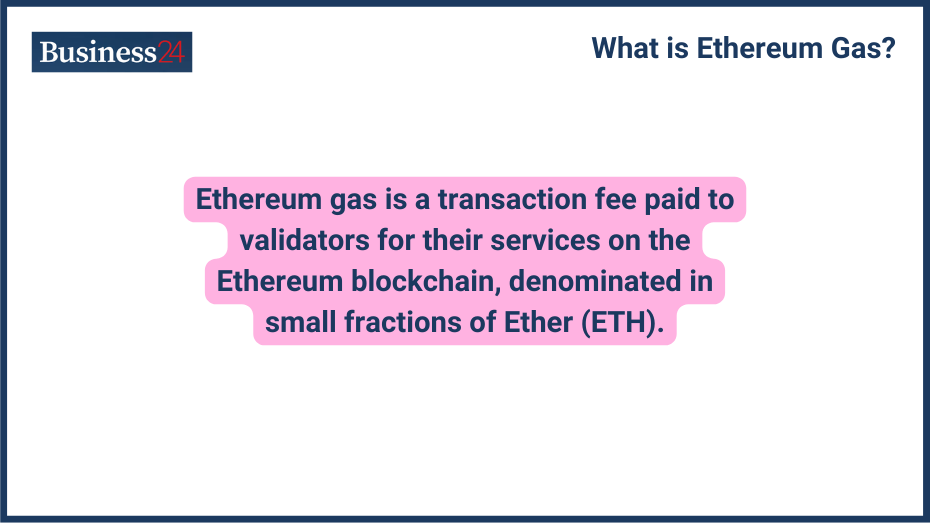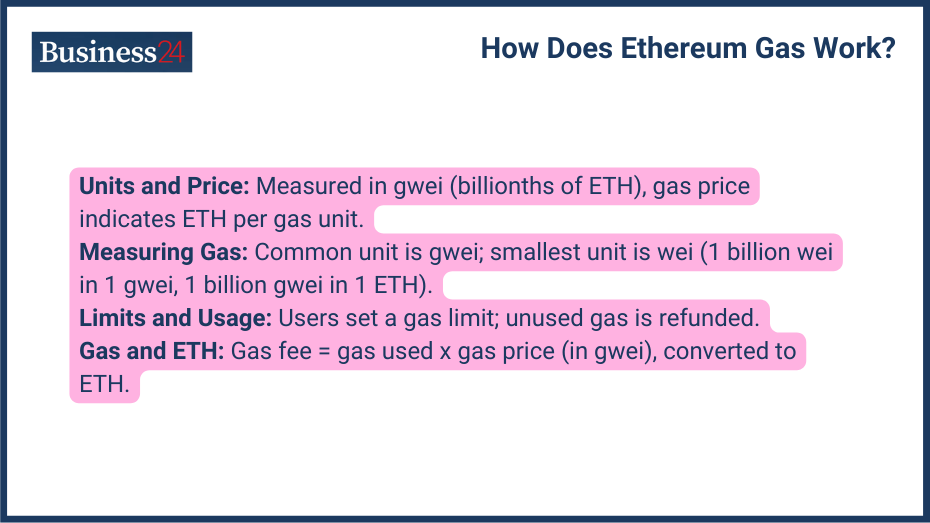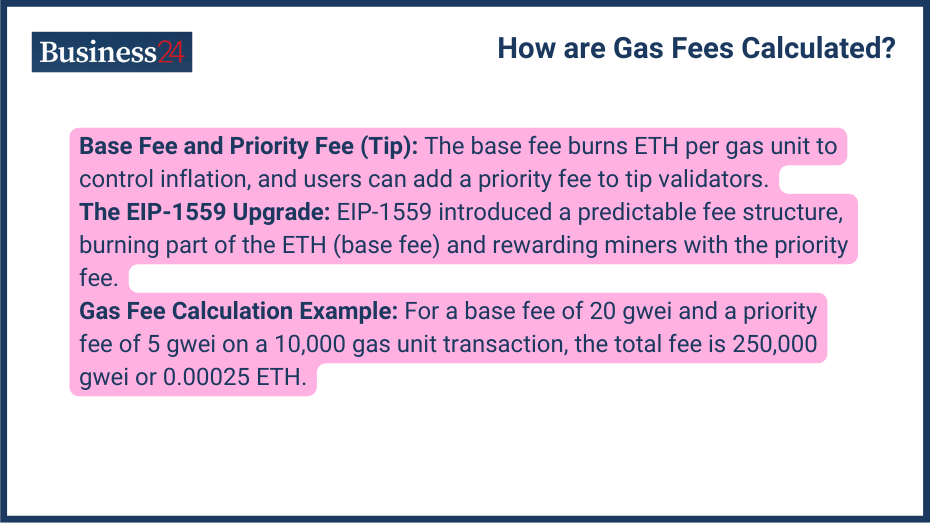
Ethereum gas is a transaction fee paid to validators for their services on the Ethereum blockchain, denominated in small fractions of Ether (ETH).
Just like you need food as fuel to operate, transactions on Ethereum require gas to be processed by the network. In simple words, you can understand it as fees required to do transactions on the Ethereum network. It is not fuel, as I related it earlier to the food example, but it is a unit that measures the computational effort required to execute a transaction or deploy a smart contract on the Ethereum blockchain.
Ethereum gas is the fundamental concept of Ethereum, and we are going to know everything about Ethereum gas in this guide.
What is the Definition of Ethereum Gas?
Ethereum Gas is a unit that measures the amount of computational effort required to execute operations on the Ethereum blockchain. It is used to allocate resources of the Ethereum Virtual Machine so that decentralized applications (dApps) and smart contracts can run securely and efficiently. Gas is paid for in Ether (ETH) and serves as a fee to prevent network abuse by requiring a cost for each transaction and computational task performed on the network.
The first purpose of the Ethereum gas is to incentivize miners and validators for their work. It is the computational power they contribute to secure the network. Also, requiring gas fees, the network is secured from spam transactions.
Ethereum gas and traditional fees are both paid for the use of network resources. However, Ethereum gas is required for the network’s work, while traditional transaction fees are charges imposed by financial institutions for processing transactions, such as bank transfers or credit card payments.
How Does Ethereum Gas Work?

As I said earlier you can think of Ethereum gas as the charges for the computational mechanics done by the network. So, whenever there is a transaction or any other use of the Ethereum blockchain, there will be some Ethereum gas required.
Here are some important points of Ethereum gas working:
- Gas Units and Gas Price: The measurement unit of Ethereum gas is gwei, which is billionths of an Ether (ETH). The gas price, denominated in gwei, represents the amount of ETH a user is willing to pay per unit of gas for their transaction to be processed.
- Measuring Gas: Gwei and Wei: While gwei is the most common unit for gas prices, the smallest unit is actually Wei. There are 1 billion wei (1,000,000,000 wei) in 1 gwei and 1 billion gwei (1,000,000,000 gwei) in 1 ETH.
- Gas Limits and Gas Usage: Users specify a gas limit for their transactions, which is the maximum amount of gas they are willing to pay for the transaction. The actual gas used by the transaction might be less than the limit, and any unused gas is refunded to the user.
- Relationship Between Gas and Ether (ETH): It’s important to understand that gas itself is not ETH. The gas fee is calculated by multiplying the gas used by the gas price (both denominated in gwei) and then converting the resulting figure to ETH.
Why is ETH gas so high?
One of the reasons why ETH gas is so high is the complex utilities like smart contracts Ethereum provides. These complex tasks are more complex than simple transactions and require more gas, leading to higher fees.
Another reason is the congestion in the network. Sometimes, because of higher demand, users compete to make their transactions processed faster, which drives the gas fees higher.
What is one gas in Ethereum?
There’s no inherent value tied to a single unit of gas (1 gwei). The value is determined by the current gas price set by users competing for faster transaction processing.
What does Ethereum pay for gas?
Ethereum pays for gas to compensate network validators for processing transactions and executing smart contracts on the blockchain. This fee incentivizes validators to use their resources to maintain and secure the network, ensuring its functionality and reliability. Gas fees help manage network congestion by prioritizing transactions based on the gas price users are willing to pay.
What are Gas Fees?
Gas fees are the fee required by the network to complete any transaction on the network. Gas fees are calculated by multiplying the gas used by the gas price. It is:
Gas used * Gas price = Gas fee.
Both gas used and gas prices are in gwei, and the final fee is converted to ETH.
There are various factors that affect the gas fees or can drive it up and down. Network congestion resulting in higher demand leads to the price, transaction complexity, and the gas price set by the influence of the total gas fee.
Also, periods of high network activity, such as during the launch of a popular dApp, can lead to significant spikes in gas fees.
The implementation of EIP-1559 has introduced a base fee that burns a portion of the gas fee, potentially leading to a slight deflationary effect on ETH. However, gas prices can still fluctuate based on network demand.
How are Gas Fees Calculated?

Before the changes in 2021, calculations were different, but after the introduction of EIP-1559 (Ethereum Improvement Proposal 1559) in August 2021, the gas fee structure underwent a significant change:
- Base Fee and Priority Fee (Tip): The base fee is a minimum amount of ETH burned per unit of gas used. The burned portion of the base fee helps to control inflation and potentially make ETH deflationary over time. Users can also tip miners and validators by including an optional priority fee.
- The EIP-1559 Upgrade and Its Impact: EIP-1559 was upgraded to address problems about high gas fee volatility and potential manipulation by introducing a more predictable fee structure. While the base fee burns a portion of ETH, the priority fee goes to the miners/validators as a reward for processing the transaction.
- Examples of Gas Fee Calculations: Let’s say the base fee is 20 gwei, and you set a priority fee of 5 gwei. If your transaction uses 10,000 units of gas, the total gas fee would be:
Gas fee = (Base fee + Priority fee) * Gas used
= (20 gwei + 5 gwei) * 10,000 units
= 25 gwei * 10,000 units
= 250,000 gwei
- Since gas fees are denominated in gwei, we need to convert this to ETH:
Gas fee in ETH = Gas fee in gwei / 1,000,000,000 (gwei per ETH)
= 250,000 gwei / 1,000,000,000 gwei/ETH
= 0.00025 ETH
Also, keep in mind that the actual gas fee will vary depending on the current base fee and the priority fee you set.
- Understanding the Gas Estimator: Many Ethereum wallets and dApps offer a gas estimator tool that can help you predict the gas price and potential gas fee for your transaction. However, these estimates are not always perfect, and the actual gas usage might differ slightly.
Who pays Ethereum gas fees?
You, me, and anyone using the Ethereum blockchain network pay gas fees. Any user initiating a transaction on the Ethereum network must pay the gas fee. Gas fees are applied for sending ETH, interacting with a dApp, or deploying a smart contract. The gas fee is paid in ETH and is deducted from the user’s wallet balance.
What are the Use Cases of Ethereum Gas?
Use cases of Ethereum gas:
- Executing Smart Contracts: Ethereum is famous for its utilities on the whole of Web 3.0. Smart contracts require computational resources to run, and Ethereum provides it. Gas fees incentivize miners/validators to allocate those resources and ensure the successful execution of smart contracts.
- Facilitating dApp Transactions: Any interaction with a dApp involves a transaction on the Ethereum network, and gas fees are required to process those transactions.
- Paying for Computation Resources: Gas essentially represents the cost of using the Ethereum network’s computational power. Users pay for the resources required to execute their transactions and smart contracts.
- Securing the Ethereum Network: By requiring gas fees, the network discourages malicious actors from spamming the network with irrelevant transactions because the attackers will require a high amount of gas fee to launch attacks.
What are the Challenges and Issues with Ethereum Gas?
Challenges and issues with Ethereum gas:
- High Gas Fees During Network Congestion: One of the most significant challenges with Ethereum gas is the high gas fees that occur during periods of network congestion. When the Ethereum network experiences high demand, the number of transactions waiting to be processed exceeds the network’s capacity.
As a result, users compete to have their transactions included in the next block by offering higher gas prices. This bidding war drives up the gas fees, making it expensive for users to execute transactions. - Impact on dApp Usability: dApp is still in the development stages. You can say it is an emerging technology, but the High gas fees can make dApps less attractive to users as the cost of interacting with the platform becomes prohibitive.
- Scalability Challenges: One of the problems Ethereum has had from the start is the scalability challenges, and gas fees are intrinsically linked to this challenge. As the number of users and transactions on the Ethereum network grows, so does the strain on the network’s capacity.
- Potential Solutions and Improvements: Several potential solutions and improvements are being developed to address the challenges associated with Ethereum gas. The transition to Ethereum 2.0, which includes moving from Proof-of-Work (PoW) to Proof-of-Stake (PoS) and implementing sharding, aims to enhance scalability and reduce gas fees by processing transactions in parallel.
Layer 2 solutions, such as Optimistic Rollups and ZK-Rollups, offer off-chain transaction processing to alleviate mainnet congestion, thereby lowering fees and increasing speed.
The implementation of Ethereum Improvement Proposal 1559 (EIP-1559) has introduced a new fee structure to make gas fees more predictable and reduce volatility.
Additionally, sidechains can handle transactions independently from the Ethereum mainnet, reducing its load. Developers are also optimizing decentralized applications (dApps) to be more gas-efficient by simplifying smart contract complexity and minimizing on-chain transactions.
How to Optimize and Reduce Gas Fees?
While eliminating gas fees entirely isn’t possible, several strategies can help you optimize and potentially reduce them:
- Timing Transactions: To reduce the gas fee, you can work on timing. Network congestion typically fluctuates throughout the day. Complete your transactions for less busy periods, often during off-peak hours or weekends, to reduce gas fees.
- Using Layer 2 Solutions: Layer 2 solutions can also offer significant gas fee reductions for specific types of transactions. You can look for Layer 2 options that suit your needs and are compatible with the dApps you interact with.
- Batch Transactions: Some wallets and dApps allow batching multiple transactions into a single one. This can be more gas-efficient than submitting individual transactions, especially for actions like sending tokens to multiple recipients.
- Gas Tokens and Refunds: Certain projects offer ERC-20 tokens that can be used to pay for gas fees, potentially at a discounted rate. Also, if there is unspent gas from transactions, it is refunded to the user.
- Understanding Gas Estimators: Gas estimators provided by wallets and dApps can help you predict the gas price and potential gas fee for your transaction. It’s not always right, but you will get an idea.
What is the Future of Ethereum Gas?
So, the future of Ethereum gas depends upon the use of the Ethereum blockchain network. Further development in the network will affect the gas fee. Ethereum 2.0 (Eth2), with its sharding technology, is expected to significantly improve scalability, potentially reducing network congestion and leading to lower gas fees in the long run.
The Ethereum development community is continuously exploring new technologies like rollups and zk-SNARKs (Zero-knowledge Succinct Non-interactive Argument of Knowledge) that could further enhance scalability and potentially lower gas fees.
Long-Term Trends and Predictions
Predicting the exact future of gas fees is not possible because there is a lot of uncertainty in cryptos, which are continuously evolving spaces. However, with ongoing development efforts and potential scaling solutions, the hope is for a more sustainable and predictable gas fee structure on the Ethereum network.
What are the Alternatives to Ethereum Gas?
While Ethereum is the dominant platform for smart contracts, other blockchains have emerged with different fee structures:
- Gas Mechanisms in Other Blockchains: Some blockchains utilize different approaches to transaction fees. For example, Cardano (ADA) employs a staking-based fee system, while Solana (SOL) uses a unique Proof-of-History (PoH) consensus mechanism to achieve faster transaction processing and lower fees.
- Comparative Analysis: Each blockchain platform has its own advantages and disadvantages. Ethereum offers a mature ecosystem and decentralization, while newer platforms might focus more on scalability and lower fees.
- Benefits and Drawbacks: Alternative blockchains may offer lower fees or faster transaction processing, but they might also be less established or have a smaller developer community compared to Ethereum.
FAQs
Q: What is one gas in Ethereum worth?
A: There’s no inherent value tied to a single unit of gas (1 gwei). The value is determined by the current gas price.
Q: What is Ethereum gas mining?
A: With the ongoing transition to Proof-of-Stake (PoS), traditional mining on Ethereum is no longer relevant. Instead, validators are chosen based on the amount of ETH they stake (hold) on the network.
Q: What is the Ethereum gas fees calculator?
A: Several online resources and tools function as Ethereum gas fee calculators. These tools estimate the gas price you might need to pay for your transaction based on current network conditions and historical data.
Disclaimer
eToro is a multi-asset platform which offers both investing in stocks and cryptoassets, as well as trading CFDs.
Please note that CFDs are complex instruments and come with a high risk of losing money rapidly due to leverage. 51% of retail investor accounts lose money when trading CFDs with this provider. You should consider whether you understand how CFDs work, and whether you can afford to take the high risk of losing your money
This communication is intended for information and educational purposes only and should not be considered investment advice or investment recommendation. Past performance is not an indication of future results.
Copy Trading does not amount to investment advice. The value of your investments may go up or down. Your capital is at risk.
Don’t invest unless you’re prepared to lose all the money you invest. This is a high-risk investment and you should not expect to be protected if something goes wrong. Take 2 mins to learn more
eToro USA LLC does not offer CFDs and makes no representation and assumes no liability as to the accuracy or completeness of the content of this publication, which has been prepared by our partner utilizing publicly available non-entity specific information about eToro.
